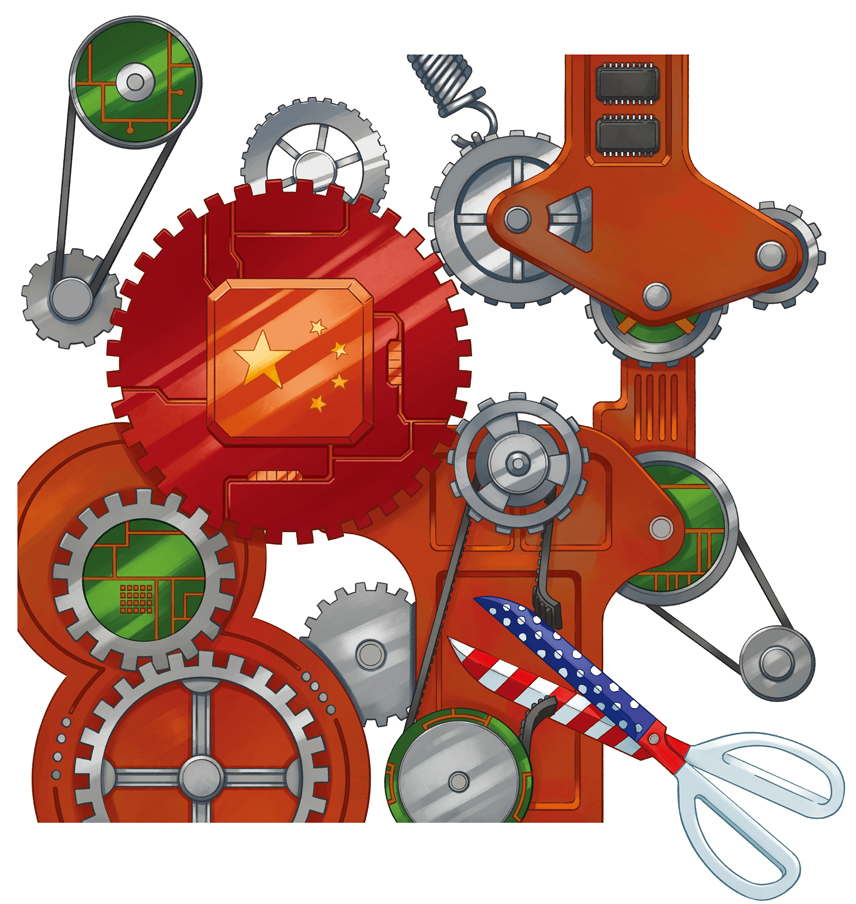
This time around, China will not miss the boat
The fourth industrial revolution (4IR) is “a fusion of technologies” that blurs the lines “between the physical, digital, and biological spheres,” according to Klaus Schwab, the founder of the Davos Forum. This fusion of so many fields will ultimately see 4IR change the world far more fundamentally than the first three industrial revolutions.
Any analysis of the many technological breakthroughs that now define this new 4IR business world, such as the internet of things (IOT), robotics, artificial intelligence and biotech, is incomplete at best if it misses the China factor. The country now accounts for nearly 20% of the world economy in terms of purchasing power parity (PPP), although this is still 10 percentage points below its share of total world output two centuries or so ago when the first industrial revolution began.
China has become a major driver of “re-globalization,” a term we coined in the 2016 Winter Issue of our magazine. It is also preparing to participate actively in 4IR and is armed with a number of advantages that give it a decided edge over other major economies.
Sinking ‘dragon boats’
China was one of the biggest casualties of the first and second industrial revolutions, triggered respectively by the steam engine and electricity. Under the Manchus, like the Mongolians hunters before them who invaded and occupied the heart of China, the Qing Dynasty lost one war after another to the “industrialized” powers from the West and Japan. That last dynasty collapsed in the early 20th century, but the country’s misfortunes continued with wars, famines and political chaos lasting until the end of the “Cultural Revolution” in the late 1970s.
Even the second industrial revolution did not arrive in China until the early 1980s, when the nation finally decided to integrate into the global economy after more than a century of isolation. China’s entrance to the modern industrialized world, which coincided with the third industrial revolution (sparked by computers), has possibly been the most significant event in human history since the first industrial revolution.
Stirring 3IR Waters
Since the early 1980s, China has managed to achieve in one generation what took five or more in the West. The country is now the second largest economy in the world and, given the recent retreat of major Western economies from globalization, its influence around the world is only likely to grow.
Here, at the dawn of the 4IR era, China is much better positioned than in the past to seize the opportunities offered by an industrial transformation. Indeed, it may be better placed than any other major economy to capitalize on the transformation ahead.
Sailing off for 4IR
The most fundamental difference between China now and in the first three industrial revolutions is the indomitable entrepreneurial spirit that has emerged over four decades of full-tilt development. Unlike in the imperial system of the Qing Dynasty when the first two industrializations hit China, and under the Soviet-type economy, in which private ownership was banned until the time of the third industrial revolution, China’s leaders today encourage people to start companies and become their own bosses.
- Magic entrepreneurship
Entrepreneurship is now at a higher level in China than in almost any other country. In 2016, over 15,000 new enterprises were registered per day. This dynamism created by millions of people seeking ways to get ahead using new technologies and business models is creating a lot of entrepreneurial “magic.”
- Integration vs Invention
Previous industrial revolutions bestowed great advantages upon countries that were early adopters. However, our age features a more level playing field in terms of speed of access to advanced modes of production. While China may still be less adept than the West in some areas of basic research, its newly unleashed entrepreneurial approach could prove a crucial advantage in the 4IR era, which will place a premium on fast-paced innovation and novel uses of existing technologies.
Alibaba is a good example. It became a global giant by cobbling together mostly off-the-shelf tools into a platform that has transformed the Chinese economy. The result is a new, far more information-efficient marketplace that gives sellers from even the most far-flung regions of China the ability to reach customers.
- From copycat to innovator
While many in the West still focus on protecting their intellectual property, Chinese companies are filing growing numbers of patents with self-developed technologies. In 2016, China ranked third after the US and Japan in international patent applications. Huawei, once bothered by IP infringement claims, is now one of the top two patent owners in the telecom industry and early this year won an IP lawsuit against Samsung.
- The power of size
As we discussed in the last issue, China is transforming from being the world’s largest factory to its biggest market. The country is the most populous on Earth and many studies show that, based on its fast expanding middle class, China will soon be the largest market for consumer products and services while remaining the largest source of manufacturing.
This is generating incredible amounts of data and means, for example, that China is already leading in facial identification, a crucial application for artificial intelligence (AI). In 2015, more than one-third of the worldwide spend on high-end bags, shoes and similar goods came from Chinese consumers. As the growth of China’s middle class continues, the country will become the main source of data that front-runners in 4IR need so desperately.
Robotics is another key area for 4IR. According to the International Federation of Robotics, thanks to its manufacturing base developed in the last four decades, China has been the world’s number-one buyer of industrial robots since 2013.
- Visible hand
The continued shift from state-owned enterprises to entrepreneurialism as the engine of change in the Chinese economy is crucial to 4IR, but the government also has a critical role to play in building the future. In its embrace of 4IR, China recognizes the mutual gains that can accrue to both the government and the economy. The nation is investing heavily in the development of 4IR across key industries. At the same time, the distributed nature of 4IR requires greater transparency, which has interesting and positive implications for China at all levels.
In January this year, Chinese leader Xi Jinping delivered a keynote speech at the World Economic Forum in Davos that drove home the importance of 4IR to China. “Unlike the previous industrial revolutions, the fourth industrial revolution is unfolding at an exponential rather than linear pace,” Xi said. “We need to relentlessly pursue innovation. Only with the courage to innovate and reform can we remove bottlenecks blocking global growth and development.”
With this industrial revolution, China has not missed the boat. Indeed, it will be among the countries steering the world along this next wave. With the inclusive and sustainable development lessons learned in the past, there is hope that this journey will be much better for everyone in the world.
















